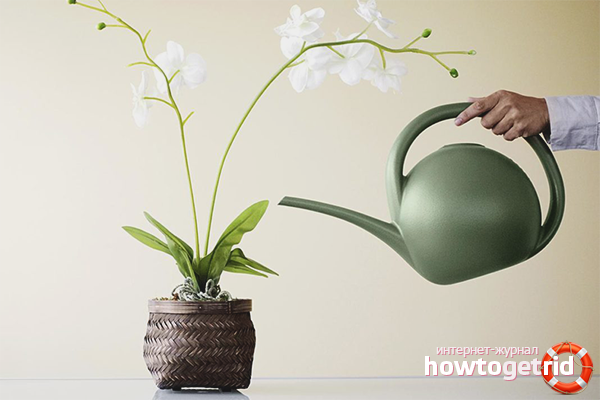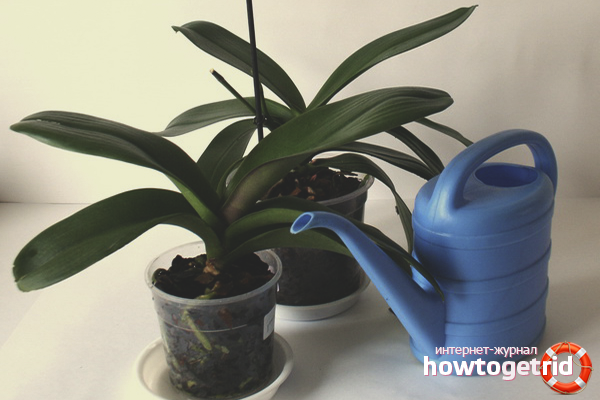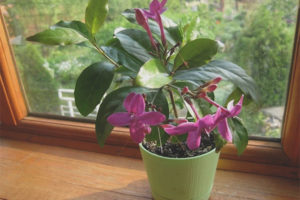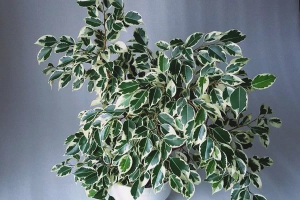The content of the article
How to water an orchid at home? Few people think about it. The vast majority believe that the more the better. And this is fundamentally wrong. After all, proper watering is in second place after lighting. And it depends on him whether your tropicana will delight you with a long elegant flowering or will it only grow foliage.
General rules
You can’t just take and pour water from above. Remember the composition of the substrate for your beauty. Solid bark or ground coconut shell. What happens if such soil is watered from above? Correctly. The liquid quickly drains down.
Now carefully look at the pot in which your orchid grows. What do we see? Holes. A lot of holes. And through them a little water will pour out. And what about the roots in the pot? Dry bark. That's how the flower was watered, from the heart of what is called. Sometimes it happens.
Some owners have the opposite. Orchid planted in greasy soil, the pot is opaque, with one hole at the bottom. And they fill the poor place every day and from the heart. Waiting for flowers, naive. And on one “beautiful” day, the Tropicana waves a leaf to such hosts and calmly leaves for another world.
Now, in order not to cause trouble, we will properly water the orchid. The most common and convenient method is designed to saturate the bark in the substrate with moisture, and not the plant itself. And this will allow the orchid itself to take as much fluid as needed at the moment. In this case, rotting of the root system, and hence the development of fungal diseases, is excluded.
What water is needed for an orchid?
Of course, not tap. And not a well. Both options have too high rigidity. This negatively affects the growth and subsequent flowering.
In natural conditions, the orchid receives the right amount of moisture from the rain. But the chemical composition of the water there does not contain half the periodic table, like rain in a metropolis. By the way, even in a small town, such a good acid rain or snow may well pass. Therefore, this option is also dismissed. Where to get water for an orchid?
From the tap. Just be sure to prepare it:
- Pour water into a saucepan or bucket. The larger your collection, the more fluid you need.
- Leave for a day at room temperature, during which time we mix well twice. This will help free chlorine evaporate faster.
- Bring to a boil and cool. Chore and what to do.
- Drain from the sediment. Everything, water is ready.
Now, directly for watering, it needs to be heated to a temperature of + 35-44 ° C. The room temperature will be chilly.
Tip. If you do not want to boil, then you can freeze water on the street or in the freezer. After thawing, it must also be drained from the precipitate.
Water the orchid. Step-by-step instruction
We carefully read the instructions. We do not make mistakes, it is fatal to flowers. The meaning of the method of proper watering is to soak a pot with a plant in water. The method is described in many sources, but the main trick is not written there. After all, it is customary to water an orchid when the substrate dries. Pot immersion is fraught with what? The bark with roots is dry, everything pops up, the plant falls on its side. Torment, not watering.
Now we will learn to do it right and without hassle. We will need:
- warm water, a lot
- small lattice, stand with holes, at worst an inverted glass with a flat bottom
- transparent container, with a diameter slightly larger than the orchid pot (plastic bucket)
- plant pot
- a small bucket, a watering can for indoor flowers or an ordinary mug
- thick old towel
Getting down.Carefully put the pot with the orchid in an empty (!) Container. We begin to pour water from above, directly into the pot. Very carefully, make sure that water does not get on the leaves, in the sinuses and growth point. Fluid will leak from the lower holes and pour into a large container. We stop when its level reaches about a third of the height of the pot with the orchid itself. The substrate will rise, but very slightly. Leave for exactly 5 minutes.
Pour some water again, as described above. When its level in a large capacity rises to about two-thirds of the flower pot, we stop again. We are waiting for exactly 6 minutes.
After this period, top up the water. We stop then when about 1 cm remains to the edge of the pot with the plant. We wait 9 minutes.
While the bark or coconut shell is soaked in water, other pots can be watered. It will turn out the conveyor. In total, the root system of the orchid was in our water for exactly 20 minutes. This is quite enough for the substrate to absorb the liquid.
Now we need to carefully remove the pot from the container. Wait for most of the water to drain. On a thick towel we already have a lattice or an inverted glass. We put a pot on it and forget it for 20 minutes. During this time, all excess moisture will flow out.
That's all, we watered the orchid correctly, you can return it to its usual habitat.
We have given the time for soaking the substrate for a pot of about 2 liters. A smaller pot takes less time. The average calculation is a full 1 minute per 100 ml of pot volume. That is, a 0.6 l vessel will get wet for 6 minutes (2 minutes each period).
Tip. How much time the pot spent in water, so much time must be given to drain the excess. Notice necessarily. Move the orchid into place prematurely - excess moisture will destroy the roots.
When is the time to water
It is argued that in winter and summer, watering should differ in timing. It's clear. That's just how to calculate these terms - it’s not told anywhere. Everywhere is an approximate time. But it's not right! Each house has its own microclimate, how can one recommend the number of days there, if everything is individual?
We reveal the secret.
For transparent pots. We periodically look at the walls outside. Condensation is present, and the roots are dark beige or brownish in color. So it's too early to water. The walls are dry inside, and the roots are closer in color to silver-white. Now is the time, you can water an orchid.
For opaque pots. We stick a wooden stick in the middle of the pot. We take out. Dry? It's time to water. Wet? Repeat the check in 2-3 days.
No sticks. No problem. Carefully rake the substrate at the edge of the pot and look at the color of the roots and the presence of moisture. Description a little higher.
In such a simple way, you can determine absolutely at any time of the year whether the orchid needs watering right now, or if it is worth while waiting for it.
Tip. Universal recommendation for any pots. Weigh it in your hand. Heavy - the crust is still full of moisture. Easy - you can water it.
Useful Tips
- In order not to freeze the root system of the orchid in winter, place foam plates or pieces of woolen fabric under the pots. Cork coasters for hot will also work.
- In extreme heat or with too dry air in the room, often moisten the air around the orchid. She loves it. Just try not to spray the flower itself, otherwise there will be ugly spots on the leaves. And if only a few drops fall into the sinuses or growth point, the tropicana can begin to hurt in general.
- Instead of spraying, you can put additional water containers next to them. With free space, it is better to place a wide pallet or tray with expanded clay, peat or moss nearby. Pour some water into it more often. Evaporating, it will create the required humidity level and microclimate around the orchid bush.
- Do not water the orchid more often than the substrate requires.In natural conditions, it also does not swim in the lake and does not grow directly in a puddle. The root system first suffers from an excess of liquid in the pot, and this is the main nutritional organ of any plant. Rot will begin, which will take a long time to heal. Is this achieved by dipping pots into the water too often?
- If you transfer the next watering about a week later, this can provoke an orchid at the beginning of flowering. Just do not abuse the method, it is too stressful for the plant. Do not be afraid, in a week without water the orchid will not die.
How to water an orchid at home? Actually, not very difficult. At first, the whole process may seem long and uncomfortable. But having completed the procedure once, you will understand all the convenience and advantage. And the orchid will definitely appreciate your efforts and will thank you with beautiful flowering.
Video: how to water orchids












Submit